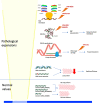C9orf72-Related Neurodegenerative Diseases: From Clinical Diagnosis to Therapeutic Strategies
- PMID: 35754952
- PMCID: PMC9226392
- DOI: 10.3389/fnagi.2022.907122
C9orf72-Related Neurodegenerative Diseases: From Clinical Diagnosis to Therapeutic Strategies
Abstract
Hexanucleotide expansion in C9orf72 has been related to several phenotypes to date, complicating the clinical recognition of these neurodegenerative disorders. An early diagnosis can improve the management of patients, promoting early administration of therapeutic supportive strategies. Here, we report known clinical presentations of C9orf72-related neurodegenerative disorders, pointing out suggestive phenotypes that can benefit the genetic characterization of patients. Considering the high variability of C9orf72-related disorder, frequent and rare manifestations are described, with detailed clinical, instrumental evaluation, and supportive therapeutical approaches. Furthermore, to improve the understanding of molecular pathways of the disease and potential therapeutical targets, a detailed description of the cellular mechanisms related to the pathological effect of C9orf72 is reported. New promising therapeutical strategies and ongoing studies are reported highlighting their molecular role in cellular pathological pathways of C9orf72. These therapeutic approaches are particularly promising because they seem to stop the disease before neuronal damage. The knowledge of clinical and molecular features of C9orf72-related neurodegenerative disorders improves the therapeutical application of known strategies and will lay the basis for the development of new potential therapies.
Keywords: ALS; C9orf72; FTD; molecular mechanisms; neurodegeneration; therapeutic strategies.
Copyright © 2022 Zampatti, Peconi, Campopiano, Gambardella, Caltagirone and Giardina.
Conflict of interest statement
The authors declare that the research was conducted in the absence of any commercial or financial relationships that could be construed as a potential conflict of interest.
Figures

References
-
- Beck J., Poulter M., Hensman D., Rohrer J. D., Mahoney C. J., Adamson G., et al. . (2013). Large C9orf72 hexanucleotide repeat expansions are seen in multiple neurodegenerative syndromes and are more frequent than expected in the UK population. Am. J. Hum. Genet. 92, 345–353. 10.1016/j.ajhg.2013.01.011 - DOI - PMC - PubMed
Publication types
LinkOut - more resources
Full Text Sources
Other Literature Sources
Miscellaneous

